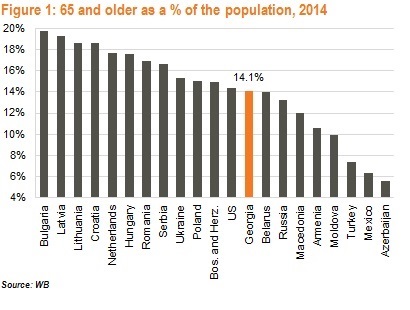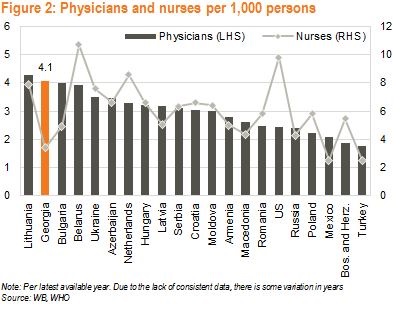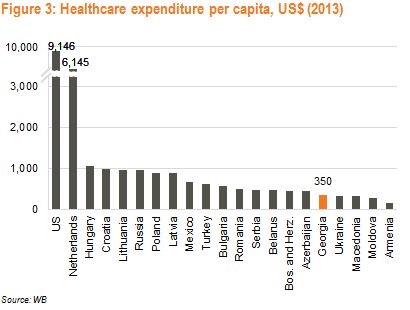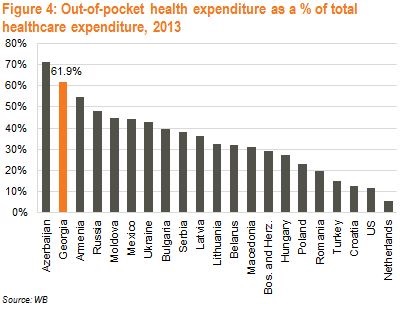Georgia's Healthcare Sector
Sector research is one of the key directions of Galt & Taggart Research. We currently provide coverage of Energy, Healthcare, Tourism, Agriculture, Real Estate, and Wine sectors in Georgia. In the previous article, we provided an overview of Georgia’s healthcare reform, while in this article we discuss the sector’s current state. The full report on Georgia’s healthcare sector can be found on Galt & Taggart’s website - gt.ge.
There are 5 major healthcare issues that governments around the world, including Georgia, face: aging population, chronic diseases, access to care, costs, and technology. While the effects of these issues are influenced by local factors, the challenges are shared around the world to varying degrees, as are the opportunities to solve them.
As elderly people demand more care, an aging population is a serious global challenge that burdens healthcare systems. The global population aged 60 or above has tripled over the last 50 years and is expected to more than triple again to nearly 2bn by 2050. The share of 65 and older age group in the total population is at 14.1% in Georgia and is expected to grow further in the long run. While the share is well above the global average of 8.1%, it is in line with the figures in peer countries.


Chronic diseases are the leading cause of mortality globally, responsible for about 80% of deaths. Chronic diseases include heart disease, stroke, cancer, chronic respiratory disease, and diabetes, all of which are common among the aging population. According to the WHO, about 30% of cancer-related deaths are due to 5 leading behavioral and dietary issues: obesity or emaciation, insufficient consumption of fruits and vegetables, a lack of physical activity, and tobacco and alcohol use.
Georgia has one of the highest mortality rates by chronic diseases of 89.7% compared to regional and income-level averages, despite having relatively low GDP per capita. Generally, real incomes and the share of chronic diseases in mortality rates are positively correlated - Georgia’s real incomes grew 2.9x or a 14.1% CAGR over 2004-12 and the share of chronic diseases increased from 82.4% in 2004 to 89.7% in 2012. Georgia’s share of chronic diseases as a cause of mortality has historically been in line with those of developed countries, where chronic diseases are a more prevalent cause of mortality as non-chronic diseases are preventable in most cases.
Access to care is another serious issue, as globally, at least 1bn persons suffer from a lack of access to care. The number of hospital beds per 1,000 persons varies greatly, from 1.5 in Mexico to 11.0 in Belarus - a clear sign of the discrepancy in access to healthcare around the world. Over 2002-13, Georgia dramatically cut its excess stock of hospital beds, a Soviet legacy, from 4.2 to 2.6 per 1,000 persons. A major part of new hospital beds came from new hospitals and obsolete bed stock has been partly renovated and partly disposed of. In terms of number of healthcare personnel, Georgia has the 2nd most physicians (4.1 per 1,000 persons) among peers (average of 3.0). In contrast, Georgia has relatively few nurses (0.8 per physician) compared to peers (2.1 average). Moreover, Georgia is the only country among peers with a ratio below 1 - a negative indicator for the healthcare sector. The WHO, in turn, recommends a 4 to 1 ratio. The undersupply of nurses imposes costs on the healthcare system, due to the resulting inefficient use of physicians’ time and skills.
Across the globe, healthcare costs are increasing rapidly, posing a serious challenge. Based on projected population growth rates, healthcare spending per capita is expected to grow an average of 4.4% annually through 2017, according to Deloitte.
For about 5.6bn people around the world, over half of all healthcare costs are out-of-pocket and 100mn people are pushed into poverty annually due to mounting healthcare costs. Evidence suggests that access to care improves with a larger share of prepayment and a smaller share of out-of-pocket payments. Despite the significant increase in public healthcare spending, Georgia still had the 2nd highest share of out-of-pocket expenditure among peers at 61.9%, compared to the peer average of 34.3% as of 2013. Annual healthcare spending per capita in Georgia has increased 5.5x from US$ 64 in 2002 to US$ 350 in 2013, a 16.6% CAGR.
Globally, healthcare is in urgent need of innovation to help stem the tide of rising costs. Advances in technologies and data management can be a tailwind for the sector, facilitating cost savings and accelerating new diagnostic and treatment methods. However, R&D costs trickle down into prices. To spur the introduction of new equipment, the Georgian government, in 2010, restricted inpatient use of equipment produced before 1998. After the reforms of 2010-11, new hospitals have been opened and additional equipment has been acquired, but up-to-date data is not available.
By and large, Georgia’s healthcare sector’s mid-term outlook looks favorable on the back of steadily increasing public and private spending. In addition, consolidation that is underway in the sector is expected to allow greater economies of scale, help improve the supply of technology and lead to better cost control, in our view.
David Ninikelashvili (Galt and Taggart)













